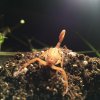I found a scorpion in my office in Los Angeles. I was shocked at first because it was my first time encountering one and it was awkward to see it inside the building. I was able to safely place it in a container because I did not want to kill it. I decided to keep it and take care of it because I was scared that if I let it go it is going to die. I have no idea how it got here and I don't know much about scorpions but I know that it would probably be extremely easy for it to die or get run over on the street. There are only buildings around with no real environment for it to live in. I know that they require water so I keep a soaked piece of cotton in the container. I have also fed it gut loaded crickets purchased from a pet shop. I keep a heat lamp on one side. I've placed a tiny container inside and covered it so that it has a hiding spot.
I think that it is the Arizona Bark Scorpion and here is why:
- It tends to cling on the wood I've placed in the container in awkward positions, sideways or upside down. This is common for this species.
- It doesn't burrow.
- It is small, about 2-4cm.
- It was found inside and they are known to slip through very small cracks.
- I've compared it to other pictures and it looks pretty similar.
I also know these are one of the most poisonous species in North America so I'm careful not to provoke it or handle it.
What I would like to know is:
- What size and kind of tank can I place it in?
- What kind of heating mat should I place on one side of the tank?
- Is it okay to only feed crickets or do I need something else? Also how often should it be fed?
- I'm aware that the best way to give it water is most likely with a shallow water dish. Any recommendations?
- What substrate should I be using? Are these desert species or more forest like? I know they like bark so I'm confused on this.
Thanks!
Here are some pictures:


I think that it is the Arizona Bark Scorpion and here is why:
- It tends to cling on the wood I've placed in the container in awkward positions, sideways or upside down. This is common for this species.
- It doesn't burrow.
- It is small, about 2-4cm.
- It was found inside and they are known to slip through very small cracks.
- I've compared it to other pictures and it looks pretty similar.
I also know these are one of the most poisonous species in North America so I'm careful not to provoke it or handle it.
What I would like to know is:
- What size and kind of tank can I place it in?
- What kind of heating mat should I place on one side of the tank?
- Is it okay to only feed crickets or do I need something else? Also how often should it be fed?
- I'm aware that the best way to give it water is most likely with a shallow water dish. Any recommendations?
- What substrate should I be using? Are these desert species or more forest like? I know they like bark so I'm confused on this.
Thanks!
Here are some pictures:




